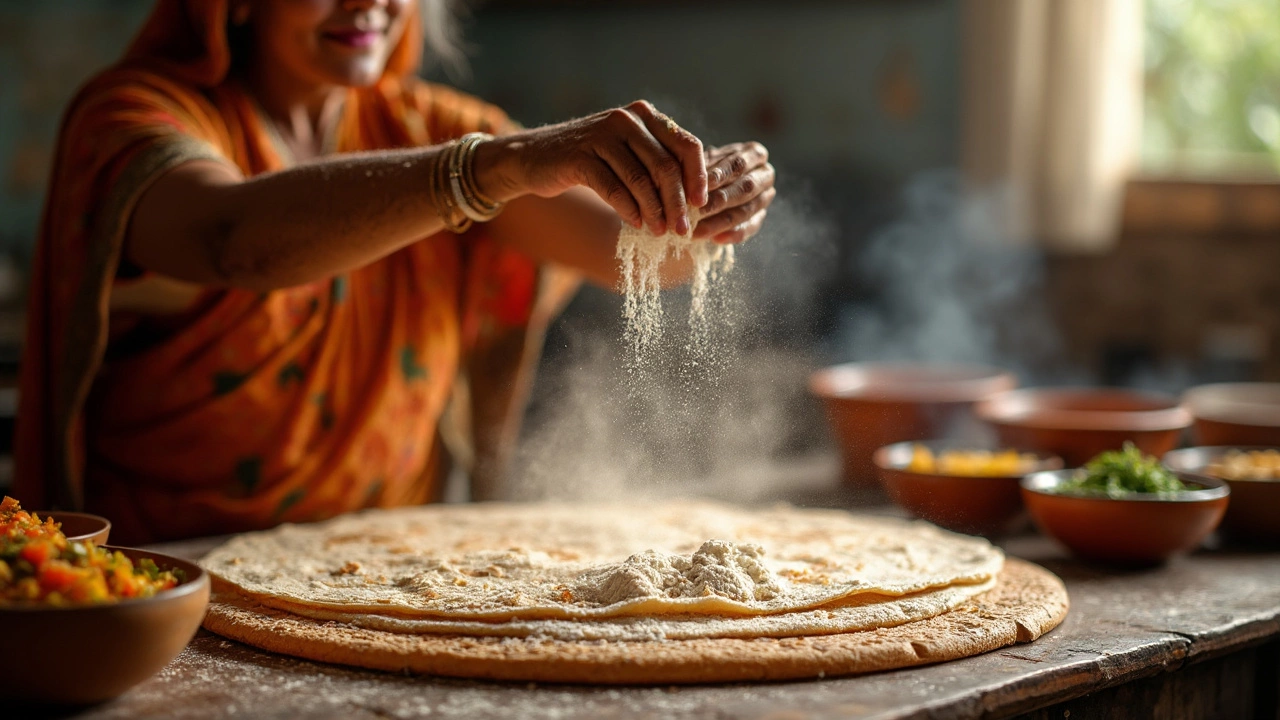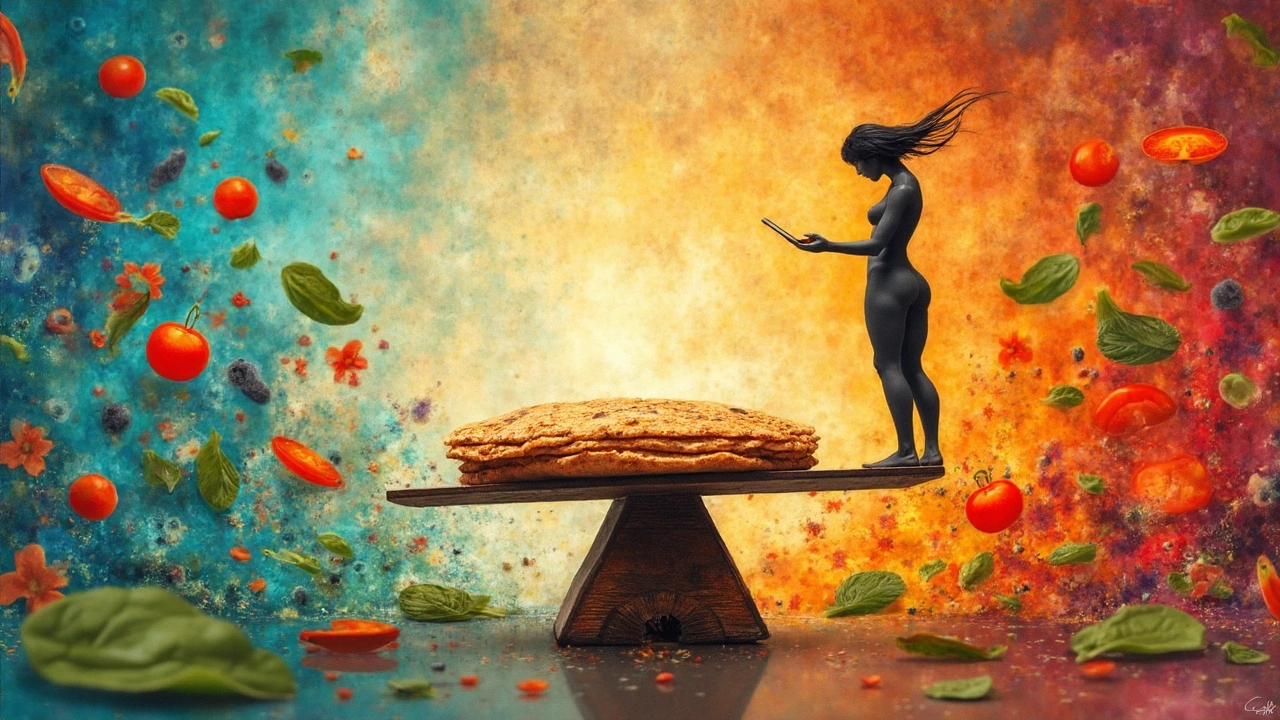Calories in 1 Roti: What You Need to Know
 Feb, 22 2025
Feb, 22 2025
Roti, the humble flatbread, is a common sight at our dining tables. But have you ever stopped to think about how many calories are in that tiny slice of heaven? Knowing the calories in 1 roti can make a big difference in managing your diet effectively.
On average, a plain, medium-sized roti contains about 70-100 calories. It can vary depending on the type of flour used or additional ingredients, but this is the range you can typically expect. Now, add some sabzi to your plate— the veggies pack in nutrients, but also bring along extra calories. And we haven’t even touched on ghee yet!
When you smear your roti with ghee, you're adding roughly 45 calories per teaspoon. That's something to keep in mind when you're reaching for that shiny golden scoop!
But don’t worry, enjoying rotis doesn't mean going on a strict diet. Instead, think of ways to balance your meals. Maybe opt for whole wheat flour or reduce the frequency of ghee-laden rotis. Small changes can lead to a healthier lifestyle without compromising on taste.
- Understanding the Calories in 1 Roti
- Roti and Sabzi Combinations
- Impact of Adding Ghee
- Making Healthier Choices
Understanding the Calories in 1 Roti
Let's unravel the mystery behind the calories in 1 roti, which often sparks curiosity. A standard roti, made with whole wheat flour, generally contains around 70-100 calories. It's quite modest considering it's a staple in many meals. Yet, understanding its calorie content can help shape more informed dietary choices.
What Makes Up a Roti?
The significant part of a roti comes from its main ingredient—whole wheat flour. Besides calories, it packs in nutrients like fiber and protein that are beneficial for your daily intake. One thing to note is that the size and thickness of the roti can influence the calorie count. A larger or thicker roti will naturally add more to your calorie intake.
"A balanced diet is not about deprivation, but about making mindful choices," says nutritionist Meera S. Rao, author of 'Healthy Plate, Happy Plate'.
How to Keep it Healthy
- Choose Whole Wheat: Go for whole wheat flour. It's more nutritious and keeps your hunger at bay longer than maida or refined flour.
- Control Portion Size: Keeping portions in check is crucial. Instead of having multiple rotis, balance your meal with salads and vegetables.
- Explore Varieties: Experiment with multigrain flour to boost the nutritional profile of your roti.
Comparing Caloric Content
It's interesting to compare the caloric content of different types of rotis. Here's a small breakdown:
| Type of Roti | Calories |
|---|---|
| Whole Wheat Roti (medium) | 70-100 |
| Maida Roti (medium) | 90-120 |
| Bajra Roti | 100-120 |
In the end, it's not just about answering how much calories in 1 roti, but understanding how those calories fit into your daily diet. By making small adjustments, you can enjoy rotis without worrying about calorie bloat.
Roti and Sabzi Combinations
When it comes to wholesome meals, calories in 1 roti and sabzi are a typical go-to choice for many. But are you aware of how they stack up in terms of calorie intake?
Let’s break it down. A plain roti, by itself, offers around 70-100 calories. Pair this with a cup of sabzi, and you might add anywhere from 100 to 150 calories more, depending on the ingredients and cooking method. Curries with oil or cream can increase these numbers significantly, so opting for lighter, steamed, or boiled veggies might be a healthier route.
Choosing Your Sabzi Wisely
- Green Leafy Vegetables: Spinach, fenugreek, and other greens are low in calories but high in nutrients. A simple sauté or steam keeps them nutritious and light.
- Lentil-Based Dishes: Lentils like daal add protein. Although they are slightly higher in calories, the protein boost makes them worthwhile.
- Mixed Vegetables: Try combinations like carrot, peas, and beans. These are still fairly light and can offer a range of vitamins and minerals.
Now, if you do enjoy creamy gravies or other richer sabzis, consider having smaller portions or balance it with additional raw salads or stirred veggies without oil. That way, you can control the calories in 1 roti and sabzi more effectively while still enjoying a variety of flavors on your plate.
Balancing Your Meal
- Track daily intake: Use apps or jot down your meal calorie estimates to get a clear picture.
- Alternate dishes: Don't stick to one sabzi; mix it up to avoid boredom and encourage varied nutrition.
- Portion control: Especially for calorie-dense foods, measure instead of guessing to stay within limits.
Creating a balanced plate allows you to savor your food without the calorie overload. So next time you're serving dinner, think less about restricting yourself and more about making informed choices that align with your lifestyle and goals.

Impact of Adding Ghee
Adding ghee to roti is a culinary tradition that elevates this simple flatbread into something special. But it also raises the calories in 1 roti significantly. Each teaspoon of ghee adds approximately 45 calories. That might sound like a small number, but it can quickly add up, especially if you're having multiple rotis in one meal.
Why is ghee added?
Ghee is cherished for its rich flavor and aroma, transforming a plain roti into a delightful treat. It's not just about taste, though. Ghee is believed to offer several health benefits, providing healthy fats that can help in the digestion and absorption of nutrients.
Balancing Flavor and Calories
There's no need to skip ghee altogether if you're mindful of its impact on your calorie intake. Here are some tips to keep in mind:
- Use a brush or spoon to spread a thin layer of ghee, reducing the amount while still enjoying the flavor.
- Limit yourself to one or two ghee-spread rotis per meal to control your calorie intake.
- Choose meals that allow you to balance these extra calories with healthier, lower-calorie sides.
How to Enjoy Ghee Wisely
If you're conscious about how much calories in 1 roti you consume, try alternating between ghee and non-ghee days. By doing so, you indulge without overindulging. Pairing ghee-laden rotis with plenty of vegetables or a light soup can also help maintain a balanced meal.
Your aim doesn't have to be eliminating ghee, but enjoying it in moderation. After all, a little balance can lead to better eating habits without taking away from your meals' joy.
Making Healthier Choices
Eating smart doesn’t have to be a drag! If you love your roti, but want to keep track of those pesky calories, here are some tips to relish your favorite meal without any guilt.
Switch to Whole Wheat
Whole wheat roti is a great choice. It's richer in fiber and nutrients compared to the regular refined flour. Plus, it adds fewer calories while keeping you fuller for longer.
Mindful Ghee Usage
Love that ghee-gloss? Totally get it. But consider limiting your portion to a teaspoon, or even sprinkle a tiny bit of it instead of spreading. You still get the taste, without adding too many extra calories.
Pair with Nutritious Sabzi
Instead of oily vegetables, opt for sabzi that's steamed, grilled, or lightly sautéed. This will not only reduce the calories in 1 roti and sabzi but also enhance the flavors without all the extra fat.
Practice Portion Control
It's tempting to grab that extra roti. Instead, start with one and assess your hunger after finishing. Often, your appetite recalibrates, saving you from those extra calories.
DIY Tracking
Keep a mental log of your daily calorie intake. Understanding how many calories in 1 roti helps you manage your meals better. There are some apps that make this easy by offering data for Indian dishes.
Let's look at some simple comparisons on a typical plate:
| Meal Component | Average Calories |
|---|---|
| Plain Roti | 70-100 |
| Roti with Ghee (1 tsp) | 115-145 |
| Vegetable Sabzi (1 cup) | 150-250 |
With these strategies, you can manage how much calories in 1 roti while enjoying every bite. Small tweaks lead to big changes, so keep experimenting until you find what works for you!